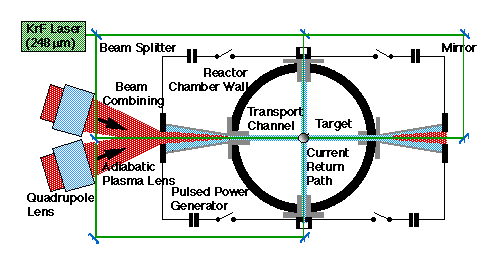Channel-Focusing Experiments
Final focusing of ion beams and their propagation in a target chamber are crucial for fusion-power production driven by heavy-ion beams. The method and technical realization of these operations have strong impacts both on the design of the accelerator and the layout of the target chamber. Most studies today are based on ballistic focusing by magnetic quadrupole lenses. With ballistic focusing, the focal spot size depends on the current and shape of the beam pulse that is delivered by the driving accelerator. To reduce space charge blow-up of the driver beam in the final-focus region, the total beam current is divided into several beams, each with an individual final-focus system and a separate beam port in the target chamber.
There are several possible alternative methods of focusing
and transporting the beam. This report describes one that is
technically challenging, but offers a number of desirable
features. The method is to strip the ions to a high charge
state and to space charge and current neutralize the beam
completely. An external focusing force is then applied to the
beam to focus and transport it to the target. One advantage
of this scheme is its physical simplicity because the beam
can be treated as an ensemble of independent particles in the
external focusing field. To create the focusing force the
magnetic field of a high current plasma discharge can be
used. This plasma-lens focusing would significantly relax the
requirements on emittance and energy spread of the beam
A further advantage of the concept is the insensitivity to
the beam current and pulse shape.

Schematic of channel focusing of heavy ion beams to an inertial fusion target
A schematic that illustrates the concept is shown in the figure. The preformed Z-discharges adiabatically focus and transport the beams to the target. A pulsed laser is used to "designate" the current channels to and from the fusion target. A high voltage applied along the channel breaks down the gas and drives several tens of thousands of amperes through the channel. The theta-directed fields generated by the channel current are sufficient to confine the heavy ion beams and precisely guide them to the fusion target. Largely because light ion fusion requires high beam currents, this approach was originally considered by researchers studying the light ion approach to inertial fusion.
We have recently performed two experiments at LBNL to
investigate this concept. The first studied the physics
of the adiabatic focusing of an intense
potassium beam generated by the 2-MeV Injector, and the
second studied the formation and interactions of free-standing
Z-discharge channels at parameters that are
appropriate for driver-quality heavy-on beams.
For comments or questions contact WMSharp@lbl.gov or DPGrote@lbl.gov. Work described here was supported by the Office of Fusion Energy at the US Department of Energy under contracts DE-AC03-76SF00098 and W-7405-ENG-48. This document was last revised June, 2002
